Scratch & Bash
:
Engines / Rolling Stock
Hand Lettering your Freight Cars
Feb 23, 2011


By David Maynard |
Author
Bio
As most of us who model, I have need for lettering. And since dry transfers are getting hard to find around here, or are a special order item. And since they never seem to be in the color I want. Come see how I solved this problem.
|
As most of us who model, I have need for lettering. And since dry transfers are getting hard to find around here, or are a special order item. And since they never seem to be in the color I want. And since I have not found them in some of the fonts I need. And since when I do use them I have all these letters left over I can't use like ZXQ and such. I decided that I would work out doing my own lettering. As you may be able to understand I am limited in how small a type of lettering I can do by hand. But since I don't tend to worry too much about the real small details that part don't bother me. So the first step is to find the type style (font) I want to use, and in the age of computers there are literally thousands to choose from. Then I print out what I want to put on what I am painting. By adjusting the font size I can make it come out whatever size I need on my printer. Or better yet I print it out as large as possible and reduce it on a copier to the correct size I need. Then on the model I lay down a sheet of transfer paper or carbon paper (remember carbon paper kids?). Transfer paper will leave white on the model where it's rubbed, and of course carbon paper will leave black. The one I use depends on the color of lettering I am doing, light colored lettering I use the transfer paper and dark colored lettering I use the carbon paper.
Then I tape the paper with the lettering (artwork) onto the model, positioning it properly. 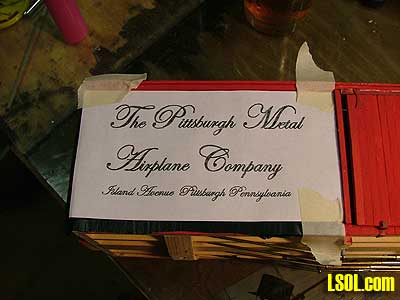
To transfer the outline I take an old ballpoint pen that has long ago run out of ink and run it firmly along the outline of the letters on the paper. 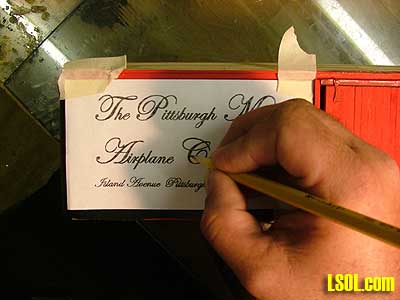
Did I mention I hardly ever throw anything away? But in the picture you see me using a pencil, today I couldn't find that pen. Have I also mentioned that I am a bit disorganized? When I use a pencil I have to keep it sharp, and that takes longer. As I go I will, from time to time, lift the paper to make sure I am getting a good image on the model, this is why I usually tape only along the top edge. But sometimes, as in this case, I need to tape along more then just the top to hold the artwork still. Then when I have a good outline of the letters I remove the papers. 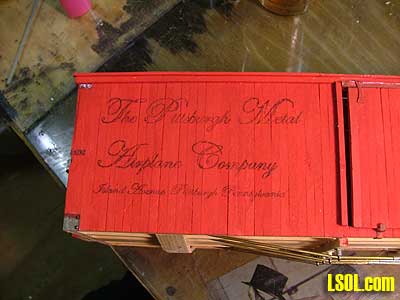
Then it's a matter of painting between the lines with a small brush. 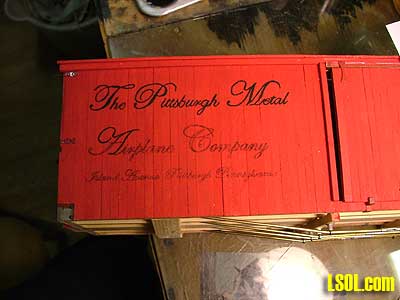
I know that right now someone out there is saying "My hand isn't steady enough to do that", well neither is mine. So when I do make a mistake I let the paint dry and then carefully scrape the error off with a new Xacto blade. 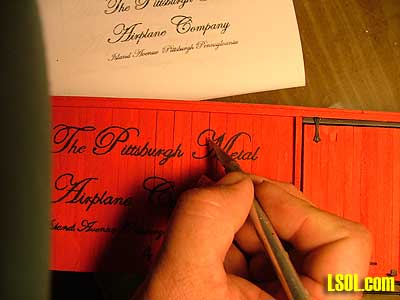
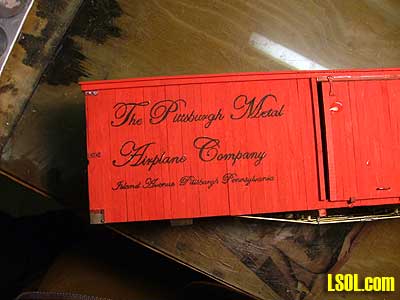 It usually takes me going over the letters about 3 times to get them filled in real nice and to fix my mistakes. Sure it is a bit time consuming, but I end up with exactly what I want with no wasted letters. And the looks on people's faces when I tell them its hand painted are priceless. 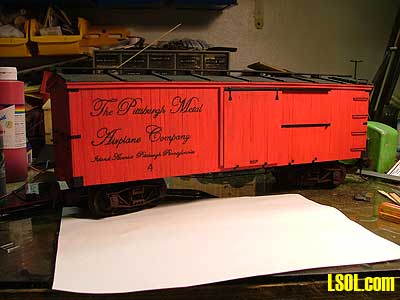
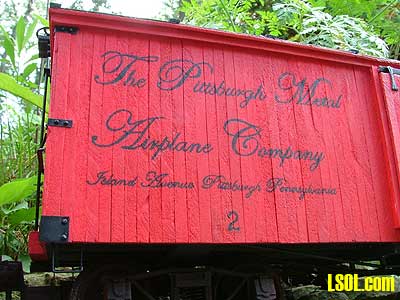 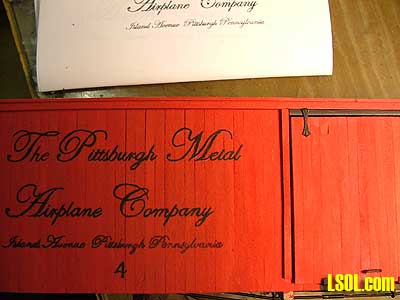
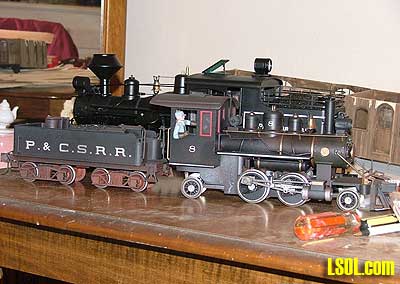
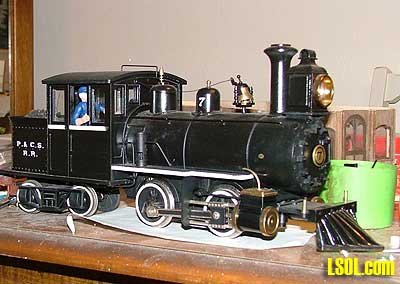 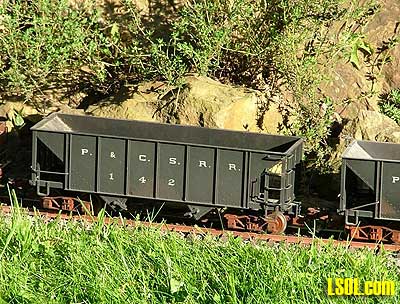
On the Pittsburgh Metal Airplane car I also numbered the car differently on each side. That way it appears that I have 2 of these cars 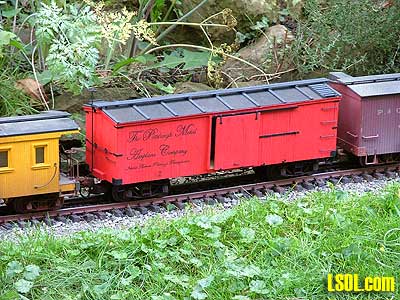
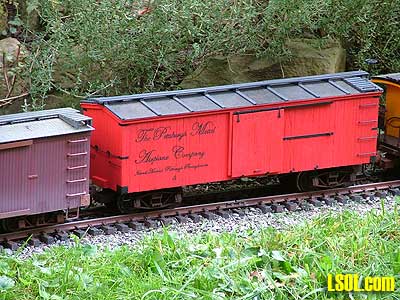
| lettering |
| What a great way to do this ... Would a permanent black marker work rather than a small brush.. I know me and I think I would probably have a sloppy mess if I did the brush thing .... whereas a pen would be far more controllable . Thanks - and this is beautiful..... |
| Carl Kokes - 02/23/2011 - 06:07 |
| Hand Lettering |
| David, I had to laugh when I read you use two differnet numbers on the "Metal Airplane" car. You're alawys finding unique things to do. Nice work! The lettering looks terrific! For those of us who are not to steady, Artists and sign painters use a dowel of some sort with a soft ball on the end held by the other hand and rest the painting hand on to help steady the painting brush. I have no idea what it's called but it must work. |
| Gary Condry - 02/23/2011 - 06:52 |
| Printing made Easy |
| YOU ARE THE MAN David!! A great way to get the printing on with nominal tools... Look out you will be taking the crown away from Kirke for being the "most resourceful with little fuss"... Loved reading the article even though I no longer have cars to print. Your concept will come in handy for any of the non-scale houses I work on. Thanks for sharing... Elaine |
| Elaine Haggenbottom - 02/23/2011 - 06:59 |
| Car Lettering |
| I've borrrowed my wife's Cricut machine to cut letters out of decal paper. Interchangeble cartridges give me font flexibility, and you can size the letters fromm about 1/4 inch to six inches! Decal sheets come in many colors and sizes. Iuse the white sheets for most lettering! |
| Dick Friedman - 02/23/2011 - 09:42 |
| Car Lettering |
| David, as light as the lettering transfered over to the boxcar, how did you see them on the black locomotive? Ron |
| Ron Hill - 02/23/2011 - 19:20 |
| Lettering |
| Nice technique I would like to give this a try. Thanks for tip. Jerry |
| Jerry Madsen - 02/23/2011 - 21:04 |
| Car Lettering |
| David, Your technique is very interesting. I am not sure that I could hand letter as well as you do, but I think this is a fine alternative to decals and dry transfers. I like the idea of using transfer paper to put white on dark surfaces. That solves the issue of putting them on the black steam locos. Thanks for sharing with us. Noel |
| Noel Widdifield - 02/24/2011 - 10:09 |
| Lettering |
| Carl, a black marker might work, but what if you slip and make a mistake? By using paint I can carefully scrape off my mistakes, and I do make them, and fix the lettering. Gary, the 2 different number trick is one I learned years ago to make my N scale fleet seem bigger. I rest my hand with the paintbrush on the model. Smaller models I hold in the other hand and press my wrists together, that way when my hands shake everything moves together. Elaine thanks, but no, Kirke can keep his title. Dick, someday I may need to lay my hands on one of them machines. For now I have a stash of carbon paper and transfer paper. Ron I used white transfer paper on the black locomotives and cars. Even though it doesn't photograph well, its visible enough to see in real life. Thanks Jerry. Thanks Noel. |
| David A. Maynard - 02/26/2011 - 06:47 |
Top of Page
|



